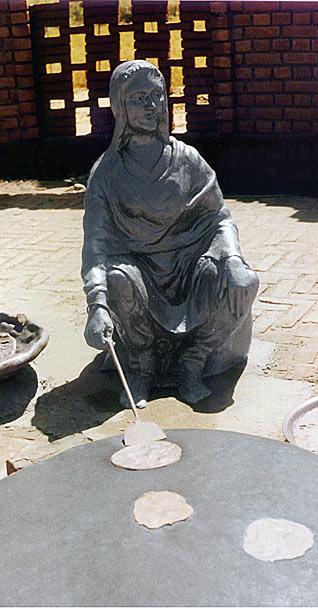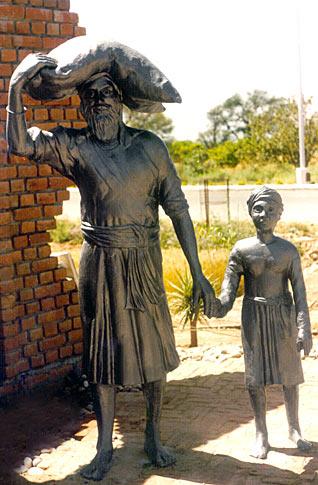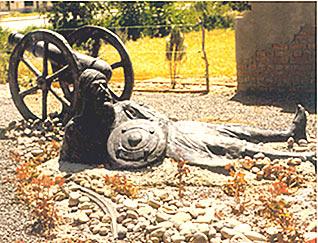Architecture
History Carved in Stone
By ADITI TANDON
A special tribute to three centuries of the Khalsa at Anandpur Sahib proudly narrates volumes on the humanistic and universal appeal of Sikhism to one and all who enter its portals. The history of the community has been captured intensely at this landscaped site which now flanks the gate to the historic city - a place dear to the hearts of Sikhs everywhere. The project, commissioned by Markfed and Punsup, was completed to coincide with the celebrations of the tercentenary of the Khalsa in 1999.
The project was given to a city-based landscaping expert, Sonia Dhami, who is the brain behind the entire structure as it stands today - a perfect supplement to the architectural beauty of the existing gates. The project has not only shaped into a technical marvel, but it also offers a wonderful insight into what Sikhi is all about. And the interesting part is that it enlightens and informs via visually appealing artwork, comprising life-size statutes, relief panels, stone wall carvings and engraved rocks and boulders. The work seems to have been planned to the last detail, as is reflected in the meaningful portrayal of every piece of concrete that has been used.
The central feature is the castle wall, and around it are smaller focal points in the form of panels, engravings, rocks and boulder compositions. The landscape has free-flowing curves which have been linked with the different points of interest, creating an eye-catching visual sequence.
In description, the site may be a maze of concrete, but in concept, it is a virtual 10-minute journey through the three centuries of the Khalsa. The layout depicts almost all aspects of history relevant to the fraternity of the Saint-Soldiers. It reflects the Khalsa's travails and tribulations; its victories and accomplishments. The project is a live screen which flashes not only the martial fervour of the Khalsa, who valiantly fought the enemy in the battlefield, but also shows their softer, humane side.
Bhai Kanhaiya is depicted offering water to enemy soldiers. The story goes that when he was confronted by some Sikhs and asked to explain his behaviour, his explanation to Guru Gobind Singh was: "Master, since I have come in touch with you, I see God everywhere and His entire creation as His children. Amongst the wounded, how can I distinguish between friend and foe?"
Yet another scene explains the dynamics of langar, the Sikh tradition which underlines the principle of universal brotherhood.
There are also a series of depictions portraying the Sikh tenets which revolve around the three pillars of daily life - kirat karo, naam japo, wand chhako (work, worship, charity). Other panels give a detailed account of Guru Nanak and his nine successors. A description of how the Khalsa came into being is also engraved on a series of rocks.
As one walks through the garden, one finds that even the vegetation has been chosen to serve a useful purpose. The plants grown symbolize the scenarios projected - the battlefield scene is depicted by the thorny cacti, while the piety of the Khalsa is portrayed by a lotus pond.
The uniqueness of Sikhi stands magnified through every little work that has been executed. Each section of the landscape - right from the relief panels, depicting the amrit baptism of the Panj Piaras (Bhai Daya Singh, Bhai Dharam Singh, Bhai Himmat Singh, Bhai Mohkam Singh and Bhai Sahib Singh) and the martial zeal of Hola Mohalla, to the rocks engraved with various achievements of Guru Gobind Singh - furthers one common objective of enlightening the visitor on the historical events related to Anandpur Sahib. The engravings speak of the significance as well as the location of various gurdwaras of this blessed city.
The sequence starts with the detail on Guru Teg Bahadur, the Ninth Guru, who founded the settlement of Anandpur Sahib by buying the land of Makhowal village on the banks of the Sutlej. Set against the picturesque Naina Devi range, this was the place where Guru Gobind Singh later created the Khalsa.
Then there are engravings on Gurdwara Guru Ke Mahal, the shrine which marks the residence of Guru Teg Bahadur. There is information on the three gurdwaras - Gurdwara Bhora Sahib, Gurdwara Manji Sahib and Gurdwara Damdama Sahib. It was at this place that Guru Teg Bahadur received the Kashmiri Pandits and heard their account of the forcible conversions they were being subjected to by Aurangzeb.
Following this is information on Guru Teg Bahadur's martyrdom and Gurdwara Sis Ganj Sahib. The engravings relate the events of the day when Guru Teg Bahadur's severed head was brought to Anandpur Sahib by Bhai Jaita. Last but not least, is the historic Akal Bunga from where Guru Gobind Singh called upon his followers to fight injustice and tyranny.
The engraved rocks also talk about the gurdwaras at Qila (Fort) Anandgarh Sahib, Qila Fatehgarh Sahib, Qila Lohgarh Sahib and Qila Holgarh Sahib - all of which mark the sites where forts were built by Guru Gobind Singh for the defence of the town. In 1701, the Guru commenced the Hola Mohalla celebrations at Holgarh, where martial games and horse riding events were organized - and the tradition has continued since then.
The entire place exudes warmth, and rightly so, for it is a labour of love, a dream come true for Sonia Dhami and her team of workers, including architect Sukumar Jeirath. The art work has been executed by Amarjit Singh Virdi and Manjit Singh in consultation with renowned Punjabi painter, Jarnail Singh. The engravings, which are concise and well drafted, have been composed in consultation with Prof Manjit Singh, Jathedar of Takht Sri Kesgarh Sahib.
The efforts of 80 labourers, six masons and 15 gardeners have produced a landscape that is a visual treat and imparts rhythm and harmony to the surroundings. As one walks out of the place, its imprint remains in the mind and so does Guru Gobind's message:
"O Lord, grant me this boon,
May I never refrain from righteous deeds;
Fearless and determined, I step into life's battle
With Thy wisdom as my guide;
Singing Thy glory, when I'm finally summoned,
May I die in the thick of the good fight."
[For further info: http://www.terrierservices.com/]
Courtesy: The Tribune
Conversation about this article
1: Balwinder (Chandigarh), March 08, 2007, 11:42 PM.
Nice to see your work. It is really GOOD.
2: sukhpreet singh (ludhiana), March 10, 2007, 11:21 AM.
Sonia Dhami and her team have almost taken on the magnitude of a university now.
3: sushma (canada), April 16, 2007, 4:56 PM.
Great article. Keep up the good work.
4: Summi (Canada), December 06, 2007, 11:56 AM.
Great Article! Good Job! I am so proud of you.
5: Brijinder Singh Bhatia (Derby, United Kingdom), February 03, 2012, 6:18 AM.
A great history of a great nation.If Maharaja Ranjit Singh's Dogra commanders had not cheated the Sikh Army and sold their services and their souls to the British, the history of the subcontinent would have been markedly different. It took another massive effort, largely by the Sikhs themselves, to throw them out eventually.






